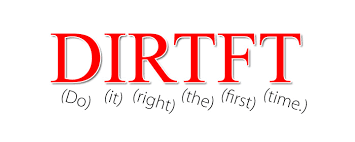Originally posted to ontheroadagainagain.com on October 27, 2014
To consistently achieve excellent results, test your work or process in a way as completely different from the original thinking as possible – ideally with no two points in common other than the beginning and the outcome.
When we check our work by reviewing it the same way we did it the first time, we often repeat mistakes – no matter how careful we are. Our minds are tricky that way.
Some examples of successful (and not-so-successful) processes:

Cross-check. Years ago, bookkeepers learned to check the accuracy of spreadsheets by cross-footing. (Yes, there were spreadsheets before VisiCalc. We used an archaic technology called pencil and paper.) First, we added all the numbers in each column, then each row. Having done this, we added the column totals and finally the row totals. Tedious, yes. But if they agreed it was very likely that the individual row and column totals were also correct.
Nowadays, we use computers that add and subtract faster and more accurately than we ever could. But they offer new opportunities to screw up. A good test in the above example is to highlight the big rectangular area with all the entries. The total of these selected cells will be displayed somewhere at the bottom of the window. Does it agree with the grand total on the spreadsheet? Be sure to check the row and column totals the same way.
A favorite error of mine is to enter a number into a cell that has a formula. It starts out OK, but doesn’t update when other entries change.

Measure twice, cut once. If you’re measuring a room, measure each door and wall segment, then measure the total and compare the results. If you measured from the south wall the first time, start at the north wall the second. Do you reach the same conclusion? If so, it’s “OK to cut.”
Another dumb Lyle mistake: Measured for a complicated piece of drywall, one with many angles . . . measured it again . . . cut it carefully . . . perfect! Unfortunately, when I went to nail it in place, the rough side was showing. I had created a mirror image of what I needed. At least I had a good pattern for the second attempt.
Listen to your instincts. One often overlooked test is our “gut” reaction. The subconscious is a powerful computer. It uses everything we’ve ever learned. In fact, many (including me) believe that we are connected beyond our own personal experience – in ways that we can’t even imagine. If a conclusion doesn’t feel right, it’s a good bet that it isn’t.
DIRTFT. Do It Right The First Time. You may have noticed that some people achieve accurate results before we do – even though they appear to be slow. But they only do it once. They don’t race to the finish only to spend time finding the mistake then do it over. Sometimes more than once.
Making “slow down to finish faster” a habit has a surprising payoff. Not only do we achieve accurate results faster initially, but as we practice our speed picks up. Just remember the priority: Right first, speed to come.
Marie and I have very different approaches to math. She’s highly creative in her approach. As a mathematician I’m baffled by her process but her results are uncannily accurate. If we agree, it’s almost certain that the result is on target. If we disagree . . . well, let’s not go there.
